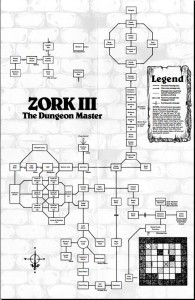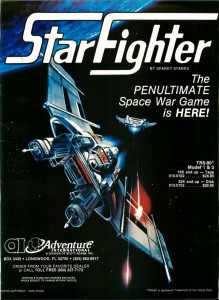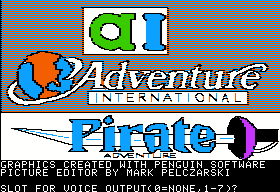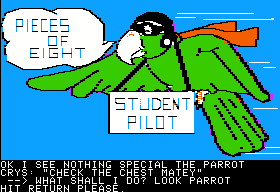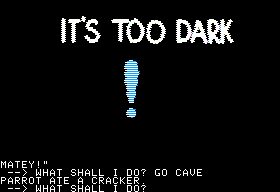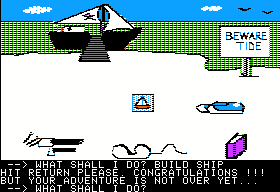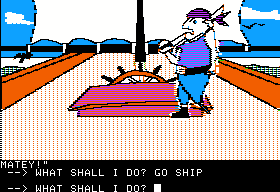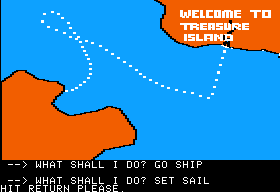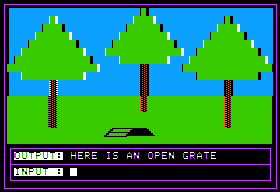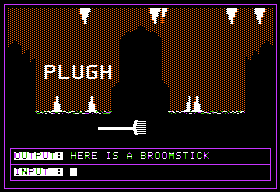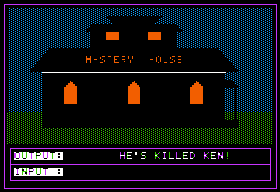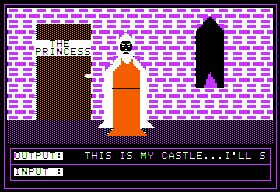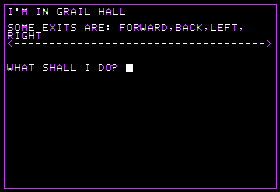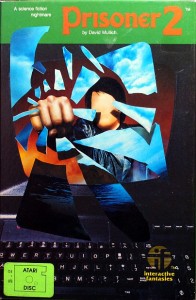Last time we explored the area west of the Junction. Today let’s head east.
There we find the Royal Museum, which houses a time machine that lies at the heart of the last of the intricate new puzzles that Blank crafted just for Zork III. It’s interesting to compare the rigorousness of Zork III‘s approach to time travel with that of Time Zone, which despite having time travel as its overarching theme swept most of its ramifications under the rug as just not worth wrestling with. Indeed, and despite the challenges that time travel presents even to authors of static fiction, temporal puzzles would continue to be something of a favorite with Infocom in the years to come.
They acquit themselves pretty well in this first effort; there’s no way to really “break” the simulation, thanks both to some surprisingly complex modeling and to some very clever restrictions on the player that straiten the scope of possibilities. In a bit of broad comedy that does somewhat lighten the generally oppressive tone of the game, we can even come face to face (albeit briefly) with Lord Dimwit Flathead the Excessive himself, a fellow who’s been an ongoing gag throughout the series thus far:
>push button
You experience a brief period of disorientation. When your vision returns, you find yourself in the middle of some kind of ceremony, with a strange flat-headed man wearing royal vestments about to break a bottle on the bars of an iron cage containing magnificent jewels. He appears somewhat pleased by your presence. He speaks very loudly, nearly deafening the poor civil servant whose duty it is to see that his wishes are carried out. "Aha! A thief! Didn't I tell you that we needed more security! But, no! You all said my idea to build the museum under two miles of mountain and surrounded by five hundred feet of steel was impractical! Now, what to do with this ... intruder? I have it! We'll build a tremendous fortress on the highest mountain peak, with one narrow ladder stretching thousands of feet to the pinnacle. There he will stay for the rest of his life!" His brow-beaten assistant hesitates. "Don't you think, Your Lordship, that your plan is a bit, well, a bit much?" Flathead gives it a second's thought. "No, not really." he says, and you are led away. A few years later, your prison is finished. You are taken there, and spend the rest of your life in misery.
** You have died **
Everything that I discuss from here on has been lifted, pretty much whole cloth, from the PDP-10 Zork. First, just south of the museum, is the Royal Puzzle, an elaborate set-piece logic game that might just be the first of the soon-to-be infamous genre of sliding-block puzzles to appear in an adventure game. This one, however, is more interesting than most of those that would follow. We must push sandstone walls around a grid to discover an important book hidden inside (easy) and make our escape with it (hard). Although one of the later puzzles to be added to the PDP-10 Zork, the Royal Puzzle was geographically located relatively early in the finished game, lying adjacent to the big maze and the thief’s lair. It was primarily the work of the most unheralded of the original Zork team, Bruce Daniels. It was cut out of Zork I for reasons of space, but Infocom obviously decided it was too good to exclude from the PC games, and so placed it here as an adjunct to the Royal Museum.
And it is a good puzzle, requiring some careful planning and even sketching, but eminently solvable. Most importantly, the process of doing so is thoroughly enjoyable. I’ve never quite understood its reputation for extreme difficulty. (An old walkthrough’s sentiment is typical: “Take a deep breath here, because you’re about to enter one of the toughest puzzles in Zork III…”). In reality, the Royal Puzzle requires only patience, careful planning, and, yes, a willingness to restore many times; one wrong push on a wall usually means rendering the puzzle insolvable. It’s not trivial, but much less daunting than some of the other puzzles scattered throughout both the PDP-10 Zork and the first two PC games that rely entirely on, shall we say, intuitive leaps. The Royal Puzzle is even very appealing as a game of its own, divorced from the context of Zork. Some at MIT treated it this way, and competed to see not just who could solve it but who could do so in the fewest number of moves.
With the Royal Puzzle behind us, we’ve now explored and exhausted all of the initially available rooms on the map. In one of its perhaps more questionable design decisions, the game now leaves us to wander about looking for something, anything new to do. Eventually we wander into the Engravings Room and stumble across a sleeping old man, who gives us access to the endgame in return for a bit of bread. Now it all comes down to working our way through a linear series of puzzles lifted from the PDP-10 Zork endgame, designed largely by Dave Lebling. The puzzles here are appropriately challenging, but, like the Royal Puzzle, mostly challenging for the right reasons. The centerpiece is a sort of weird vehicle that we must figure out how to direct. As Jason Dyer noted in his own excellent write-up of the PDP-10 Zork, we find ourselves straining here to visualize an elaborate device described solely in text — described, in fact, in what is likely the longest contiguous infodump to be found anywhere in the trilogy.
Inside Mirror
You are inside a rectangular box of wood whose structure is rather complicated. Four sides and the roof are filled in, and the floor is open.
As you face the side opposite the entrance, two short sides of carved and polished wood are to your left and right. The left panel is mahogany, the right pine. The wall you face is red on its left half and black on its right. On the entrance side, the wall is white opposite the red part of the wall it faces, and yellow opposite the black section. The painted walls are at least twice the length of the unpainted ones. The ceiling is painted blue.
In the floor is a stone channel about six inches wide and a foot deep. The channel is oriented in a north-south direction. In the exact center of the room the channel widens into a circular depression perhaps two feet wide. Incised in the stone around this area is a compass rose.
Running from one short wall to the other at about waist height is a wooden bar, carefully carved and drilled. This bar is pierced in two places. The first hole is in the center of the bar (and thus the center of the room). The second is at the left end of the room (as you face opposite the entrance). Through each hole runs a wooden pole.
The pole at the left end of the bar is short, extending about a foot above the bar, and ends in a hand grip. The pole has been dropped into a hole carved in the stone floor.
The long pole at the center of the bar extends from the ceiling through the bar to the circular area in the stone channel. This bottom end of the pole has a T-bar a bit less than two feet long attached to it, and on the T-bar is carved an arrow. The arrow and T-bar are pointing west.
Dyer describes this puzzle, appropriately if anachronistically, as Myst-like. But of course the elaborate mechanisms of Myst are shown and manipulated graphically. And indeed, one is left just wishing for a picture after reading that mess, even as meticulously described as it is. Already Infocom, the gaming world’s foremost proponents of the power of pure text, were brushing against some of its limitations. (Notably, Bruce Daniels chose to represent the Royal Puzzle with simple ASCII diagrams rather than even trying to describe it in prose.)
Moving on, we meet the Dungeon Master at last. Zork III thankfully omits the Zork trivia quiz that the PDP-10 version requires us to pass to gain access to his inner sanctum, the final area of the game.
"I am the Master of the Dungeon!" he booms. "I have been watching you closely during your journey through the Great Underground Empire. Yes!," he says, as if recalling some almost forgotten time, "we have met before, although I may not appear as I did then." You look closely into his deeply lined face and see the faces of the old man by the secret door, your "friend" at the cliff, and the hooded figure. "You have shown kindness to the old man, and compassion toward the hooded one. I have seen you display patience in the puzzle and trust at the cliff. You have demonstrated strength, ingenuity, and valor. However, one final test awaits you. Now! Command me as you will, and complete your quest!"
The Dungeon Master becomes our partner; we must order him about to solve the final puzzle. Played after Zork II‘s similar puzzle involving the robot, one is chiefly struck by how much easier and cleaner it now is to communicate with others, thanks to the new conversation system Infocom developed for Deadline and incorporated here.
Given the description of the Dungeon Master shown above and the fact that we’ve been collecting equipment to “become” him throughout the game — not to mention the brooding, weighty tone of everything so far — the final subversive twist of the game and the trilogy don’t come completely by surprise. Still, when we take our place as the Dungeon Master it brings a chill. We’re a long way from jocular treasure hunts now.
On a desk at the far end of the room may be found stock certificates representing a controlling interest in FrobozzCo International, the multinational conglomerate and parent company of the Frobozz Magic Boat Co., etc.
As you gleefully examine your new-found riches, the Dungeon Master materializes beside you, and says, "Now that you have solved all the mysteries of the Dungeon, it is time for you to assume your rightly-earned place in the scheme of things. Long have I waited for one capable of releasing me from my burden!" He taps you lightly on the head with his staff, mumbling a few well-chosen spells, and you feel yourself changing, growing older and more stooped. For a moment there are two identical mages standing among the treasure, then your counterpart dissolves into a mist and disappears, a sardonic grin on his face.
For a moment you are relieved, safe in the knowledge that you have at last completed your quest in ZORK. You begin to feel the vast powers and lore at your command and thirst for an opportunity to use them.
Much of what’s just happened is still very vague, with, as was so typical of adventure games of this era, the details all left to the imagination. Yet in this case, rather than seeming an artifact of technical constraints or just a lack of talent for fiction, the vagueness works. One senses that careful explanation would only spoil it. Given how powerful this ending is, one has to feel happy that Infocom decided not to cheapen it with a Zork IV. And, as Jason Dyer also noted, it’s hard not to want to read this ending meta-textually: “Here is a new art form, one raw and unrefined, with the potential to be serious and profound.” The last paragraph, which is not found in the original version but only in Zork III, adds to the impression. The last sentence might even apply to the way that Infocom themselves were feeling at just about this moment. And justifiably — they had a remarkable next few years in store.
That, then, is Zork III. As many remarked at the time, sometimes disapprovingly, it’s considerably shorter than either of its predecessors, with a total number of real puzzles that could probably be counted on your fingers. Yet it occupies roughly the same space as the earlier games on disk. In place of sprawl and “cheap” puzzles like mazes and riddles, Blank implemented a smaller number of more intricate, satisfying interactions. He implemented, in other words, deeply rather than widely, beginning a trend that has persisted in interactive fiction right to the present day. This, combined with that pensive, fraught atmosphere that seems to affect everyone who plays it and its subversive thematic focus, make Zork III feel like a leap toward not only a more satisfying approach to adventure gaming but also that ineffable thing called Art.
